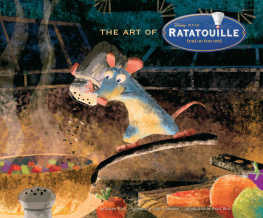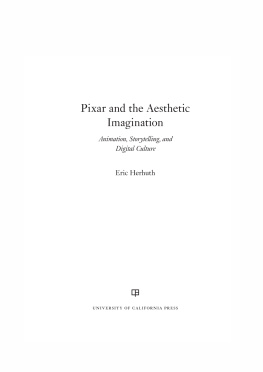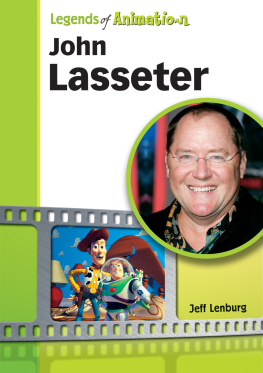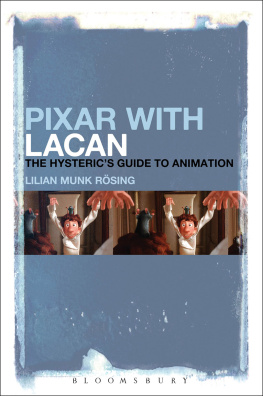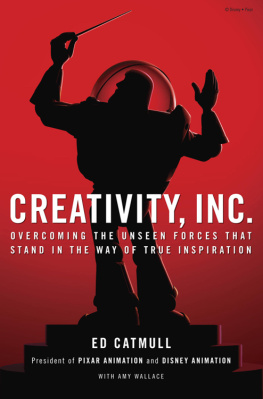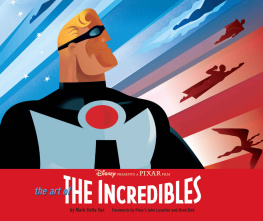
Woody and Buzz. Rendered character pose.

Copyright 2007 by Disney Enterprises, Inc./Pixar Animation Studios.
All rights reserved. No part of this book may be reproduced in any form without written permission from the publisher.
ISBN-13: 978-0-8118-5012-4 (hc)
ISBN-13: 978-1-4521-4765-9 (epub, mobi)
Designed by Tolleson Design
Chronicle Books LLC
680 Second Street
San Francisco, California 94107
www.chroniclebooks.com
: Buzz Lightyear. Rendered character pose.
Credits:
, Brent Schlender, Pixars Magic Man, Fortune, May 2006.
, Steve Jobs, excerpt from interview by Daniel Morrow, Smithsonian Instituion Oral and Video Histories, April 20, 1995.
, Steve Jobs, excerpt from commencement address, Stanford University, June 12, 2005.
Mr. and Mrs. Potato Head are registered trademarks of Hasbro, Inc. Used with permission. Hasbro, Inc. All rights reserved. POOF-Slinky, LLC.
Materials and characters from the movie Cars. Copyright 2007 Disney/Pixar. Disney/Pixar elements Disney/Pixar, not including underlying vehicles owned by third parties; and, if applicable: Volkswagen trademarks, design patents and copyrights are used with the approval of the owner Volkswagen AG. Chevrolet Impala is a trademark of General Motors. Hudson Hornet is a trademark of Chrysler LLC. FIAT is a trademark of FIAT S.p.A. Mercury is a trademark of Ford Motor Company. Porsche is a trademark of Porsche. Jeep and the Jeep grille design are registered trademarks of Chrysler LLC. Sarges rank insignia design used with the approval of the U.S. Army. Plymouth Superbird is a trademark of Chrysler LLC. Petty marks used by permission of Petty Marketing LLC. Background inspired by the Cadillac Ranch by Ant Farm (Lord, Michels and Marquez) 1974.
Foreword

As we look back at Pixars first twenty years, we are amazed by how this company has grown. Its a great gift to be able to support yourself doing work that you love, and all of us have been honored to see our characters and stories find a place in the world outside our studio.
The people who go to see our movies are trusting us with something very importanttheir time and their imagination. So in order to respect that trust, we have to keep changing; we have to challenge ourselves and try to surprise our audiences with something new every time.
The thing about doing something new, of course, is that you never know whats going to happen as a result. But thats never stopped anyone at the studio, and that spirit of adventure is the thing that makes us most proud to be part of the Pixar community.
Its been our privilege to work with the great people whose dedication, incredible range of talents, and uncompromising standards have made this studio what it is. They have surprised and inspired us every day for over twenty years.
John Lasseter, Steve Jobs, and Ed Catmull
Introduction
Pixars seen by a lot of folks as an overnight success, but if you really look closely, most overnight successes took a long time. STEVE JOBS
As the Pixar saying goes, In the computer, nothing is free. A virtual world begins as the most purely blank slate one can imagine. There are no sets, no props, no actors, no weather, no boundaries, not even laws of physics. The computer is not unlike a recalcitrant genie, prepared to carry out any order you give itbut exactly and no more than that. So not only must every item be painstakingly designed and built and detailed from scratch, every physical law and property must be spelled out and applied. Otherwise, lamps fall through tables; rocks hover in midair; teeth shoot out of a superheros head.
It took many years for even the most dedicated and able researchers to find their way in this environment, which requires one to denature and dissect ones intuitive grasp of the world. In 1972, when computer scientist Ed Catmull first started thinking about using computers to create animated feature films, the field of computer graphics was still so unsophisticated that one could only form images with straight lines. Not many people could look past those crude and clumsy pictures to see what the medium had the potential to be. In fact, to the casual observer, the idea of using such a laborious, unspontaneous tool to create animationitself a medium in which there are never any happy accidents, only carefully planned resultsprobably seemed like an exercise in self-punishment. But Catmull persisted. He knew what could be achieved, and he was willing to work, build his team, and wait.
More than ten years later, that patience was rewarded with the perfect artistic partner. Like Catmull, John Lasseter, one of the first animators to take an interest in the medium, looked at the chunk of charcoal and saw a pencil. He, too, saw that while a computer could be demandingsometimes maddeningto use, it also had the potential to be a tool of unbelievable delicacy, reach, and control. Lasseter calls computer animation the mystical science: give the computer the right set of instructions to carry out, and you can create the impossible in a world with a physicality and seamlessness no other medium can match. And from their very first project together, it was clear that the warmth of Lasseters storytelling and the Lucasfilm Computer Divisions technical wizardry was a transformative combination. But feature animation still represented a wildly ambitious use for a medium just finding its feet, one in which stories literally had to pull new technology into existence in order to be made. Not only was there no path to follow, there would be no destination unless they could figure out how to build it.
It was Steve Jobs who placed the long bet on that dream, buying the Lucasfilm Computer Division in 1986 and giving it a new life as Pixar. Pixar is known today as a successful movie studio. But its run of films from Toy Story in 1995 to Cars in 2006 is literally only half the companys story. For all the success of its second decade, Pixar spent much of its first decade struggling to survive, putting together a modest body of work in short films and commercials as it slowly built the technological and creative foundation necessary to achieve its goal of making the worlds first computer-animated feature film.
As they grew Pixar from a 40-person hardware company into an animation company, and eventually the 900-person movie studio it is today, Catmull, Lasseter, and Jobs consistently found that what was true of their medium was true of their company: if they wanted it, they had to create it. The technology, the creative team, the filmmaking opportunitynone of these existed to be acquired.
Happily, their partnership proved to have the perfect combination of essential talents. Catmulls technical expertise helped attract many of the finest minds in computer graphics, people committed to constantly advancing the medium, to making it a tool that could offer something truly new to storytelling. Lasseters discerning eye and collaborative spirit sought out artists capable of rolling with the punches in a medium that was essentially still a frontier town, and brought them together into a creative community the likes of which hadnt been seen in decades. And Jobs, the companys pathfinder and guardian angel, had the guts to back Pixar in the hard times and the savvy to guide it past pitfalls that would have swallowed it otherwise. Most important, all three shared an absolute dedication to quality above all elsea commitment that never wavered in the face of either success or failure.
Next page

